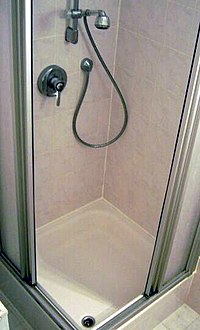 |
| Basic Shower with adjustable nozzle |
A shower (or shower-bath, walk-in wash, vapor shower) is a location in which a person bathes under a squirt of water. A wash benefits less water than a bath: 80 liters on average for a wash contrasted to 150 liters for a bath.
Some Historical View
The initial wash rooms were neither indoor organisations neither man-made, but were widespread natural formations: waterfalls. The falling water rinsed the bathers absolutely clean and was more effective than bathing in a traditional basin, which needed manual transport of both fresh and waste water. Ancient persons began to reproduce these natural phenomena by pouring jugs of water, often very cold, over themselves after cleaning. There has been clues of early upper class Egyptian and Mesopotamians having inside wash rooms where servants would bathe them in the privacy of their own homes. although, these were rudimentary by modern measures, having rudimentary drainage schemes and water was conveyed, not pumped, into the room.
The ancient Greeks were the first people to have wash rooms. Their aqueducts and waste schemes made of lead pipes permitted water to be pumped both into and out of large communal wash rooms utilised by elites and common people alike. These rooms have been found out at the site of the city Pergamum and can furthermore be found comprised in pottery of the era. The portrayals are very alike to modern locker room wash, and even encompassed bars to suspend up clothing. The ancient Romans furthermore pursued this convention; their well known bathhouses can be found all round the Mediterranean and as far out as modern-day England. The Romans not only had these wash rooms, but furthermore believed in bathing multiple times a week, if not every day.
The advanced water and waste schemes developed by the Greeks and Romans rapidly smashed down and fell out of use after the drop of their empires. It was not until the 19th century that a scheme nearly as convoluted or reliable as the Greek and Roman sewers was rebuilt. The first wash rooms in the up to date era were self-contained units where water could be reused several times. In the early 19th century (probably around 1810, though there is some contradiction amidst sources), the English Regency Shower was anonymously invented. The original design was over 10 feet (3 m) big, and was made of some metal pipes decorated to gaze like bamboo. On the top of the unit was a basin attached to these pipes. The water was pumped through a nozzle and over the occupant's shoulders before being collected and pumped back into the basin. This prototype went through some renovations encompassing hand-pumped forms, forms with some sprayers, and those with interchangeable nozzles. The reinvention of dependable indoor plumbing round 1850[7] permitted the free-standing wash rooms to be connected to a running water source, making them simpler to use.
 |
| Rib Shower |
The first modern wash was utilised in 1860 by the French armed detachment, as an economic hygiene assess, which installed communal showers in barracks. The system was adopted in 1872 by François Merry Delabost, a French medical practitioner and inventor, who when he was surgeon-general in Bonne Nouvelle jail in Rouen, France replaced one-by-one bathing tubs with mandatory communal wash rooms for use by prisoners, contending that they were more financial and hygienic. The French scheme of communal wash rooms was taken up by other armies, the first being that of Prussia in 1879, and by prisons in other jurisdictions. They were furthermore adopted by boarding schools, before being established in public bathhouses. The first shower in a public bathhouse was in 1887 in Vienna, Austria. In France, public bathhouses and wash rooms were established by Charles Cazalet, foremost in Bordeaux in 1893 and then in Paris in 1899.
The boost in get access to to warmed water made bathing more comfortable and popular. Even with the new improvements in their conceive, the shower remained less well liked than the bathing tubing tub in industrialised nations until the second half of the 20th century.
Two Types of Shower
Domestic
Household wash rooms are most routinely stall wash rooms or wash rooms over a bathtub. A stall shower is a dedicated shower area which uses a glass door to comprise water spray. The shower over a bathtub keeps bathing room space and enables the area to be used for either a bathing tub or a wash and commonly benefits a sliding wash backdrop to contain the water spray. Wash rooms may furthermore be in a wet room, in which there is no contained wash locality, or in a dedicated shower room, which does not require containment of water squirt. Most household wash rooms have a lone overhead wash head, which may be adjustable.
Public
Numerous modern athletic and aquatic facilities provide wash rooms for use by patrons, routinely in gender segregated changing rooms. These can be in the pattern of one-by-one stalls shielded by curtains or a door or communal wash rooms. The latter are usually large open rooms with any number of shower heads established either directly into the partitions or on mails throughout the wash area. Open washes are often supplied at public swimming pools and at popular sandy shores.
Infantry forces around the world set up area wash rooms to endow the washing away of dangerous residue from modern weapons such as caustic chemicals, dangerous biological agencies, and radioactive materials, which can harm forces on both edges of a conflict.
No comments:
Post a Comment